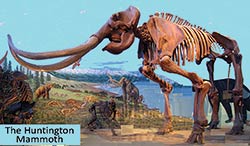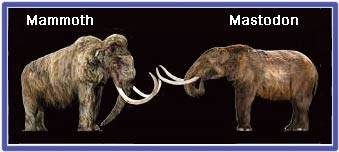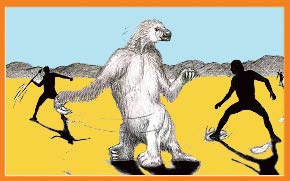 |
| Utah’s Huntington Mammoth was 95% complete. It died at 9000 feet elevation. |
The “Ice Age” is one of the best-known episodes in prehistory. The Mammoth, Mastodon, Wooly Rhinoceros and giant Ground Sloth were iconic, monstrous denizens of the icy wastelands that gripped much of the planet. The 20-year-old Ice Age movie franchise has its’ sixth movie in production. Let’s not forget the saber-toothed cat and cave bear. All these large mammals represent the “megafauna” of the Pleistocene epoch which lasted from almost 2 million, until only 10,000 years ago. During this epoch, huge ice sheets advanced with each glacial maximum phase and retreated with interglacial warming phases. The last interglacial maximum (IGM) was between 35,000 and 10,000 years ago, when all of Canada was under an Ice sheet more than two miles thick, and glaciers were widespread in the Rocky Mountains. Geologists believe we are now living in an interglacial phase that could eventually cycle into a new glacial maximum, although global warming may prevent this. Humans migrated into North America at least 25,000 years ago during the last IGM, when the continent was connected to Asia by the Bering Land Bridge. As icesheets had locked up water, sea level was much lower creating land and ice bridge migration routes. Popular concepts of Ice Age life show cave-dwelling humans battling Mammoth and Cave Bear with fire and spears. Countless hunt sites around the world prove human did hunt down megafauna species. One of the most recent finds from White Sands New Mexico revealed a mix of human and giant Ground Sloth footprints indicating a hunting scenario.
 |
| The wooly mammoth and mastodon had different anatomy. Prehistoric cave artists showed the mammoth’s shoulder hump. |
Why so many big megafaunal animals during an ice age? A favorite explanation is that large animals maintain body heat better, especially when well insulated. Some Wooly Mammoth from Siberia are still frozen in permafrost. Their “wooly hair” is preserved, and the meat can still be eaten. They had big shoulder humps which show up in Ice Age cave art. In the late 1980s, a relative of the Siberian species, called the Columbian Mammoth (named after Christopher Columbus) was found near Huntington, Utah and excavated by the Utah State Paleontologist David Gillette. He said of this lucky find, coinciding with his first days on the job, that it was 95% complete and “so fresh that we thought we could smell rotting meat in one place.” The animal had died at an elevation of ~ 9,000 feet, and was found by a construction crew. A generation later, in 2010, another construction project unearthed a huge find at Snowmass Colorado, near Aspen, also at almost 9000 feet. The rich assemblage yielded remains of 4 mammoth, 35 mastodon, 10 giant bison, 3 Jefferson’s ground sloth named for President Thomas Jefferson, a big paleontology enthusiast. Remains of deer, horse and camel were also found. The site, a mountain lake deposit, yielded many firsts: the world’s largest mastodon assemblage and the highest altitude finds of bison and sloth. More than 100 species of plants included forage for these large herbivores. No cave bear or saber-tooth cave lion remains were found.
 |
| Depiction of early Americans in a sloth-hunting skirmish. Based on footprints found at White Sands New Mexico. |
Why did the megafauna go extinct? One controversial theory argues that prehistoric humans hunted them to extinction. Although driving buffalo over deadly jumps, would kill many, the estimated pre-Columbian population was huge, at 30 - 60 million around the year 1492. [It was Europeans with firearms who drove them to near extinction long after the Pleistocene megafauna was gone]. Major climate change was surely a factor. Towards the end of the Age of Dinosaurs many species became “mega-dinosaurs.” So, evolution goes in dynamic cycles, often beginning with smaller species and ending with gigantism. The loss of the megafauna may represent a ‘natural’ life cycle and not the fault of our hardy Ice Age ancestors.
|